This is the first of two BMG boxes of Mravinsky-conducted recordings. Each
comprises ten discs in a slip case. The slip case for Box 1 is of light card
by contrast with the heavy duty box for No. 2. Each disc is available separately.
The recordings emanate from radio tapes of live concerts, studio broadcasts
and commercial Melodiya recordings. The first box has a higher quotient of
more recent recordings and technical quality tends to be better although
in the face of Mravinsky's raw intensity issues such as sound quality are
often lost sight (and sound) of seconds into the disc.
A common strength of the set are insert notes (trilingual) from Dr Sigrid
Neef. These seem to have been prepared after some time-consuming research.
They certainly suggest dedication and make for great illumination in the
way they, wherever possible, concentrate on the background to the recording
and Mravinsky's performance history for that particular work.
Given the amount of music in these boxes all I can do is to provide notes
on my impressions of the performances. I am aware that there is a considerable
investigative literature and discography mapping out the provenance of various
Mrav recordings. I cannot provide that expertise here but I can speak as
an enthusiast (balanced, I hope) of fine Russian recordings and of Mravinsky
in particular.
Full discographical information is given in the booklets. Playing times are
generous.
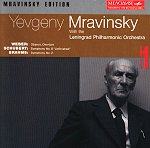
Vol. 1 WEBER SCHUBERT BRAHMS -
rec 1978 live
There are two strands in these sets: the German classical mainstream and
the Russian nationalist. The Weber Oberon is full of Teutonic magic and
refinement. The same can be said of the Schubert Unfinished which in its
tragic stride always seemed ahead of its time and certainly more tragic than
Schubert's so-titled symphony. The Brahms 2 lilts and dances in an autumnal
glow.
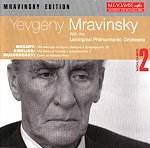
Vol. 2 MOZART SIBELIUS MUSSORGSKY
rec 1965
In this coupling we span the two streams. The Mozart (Figaro overture and
Symphony No. 34) is precise and full of lively bounce. The Mussorgsky is
intense and, in its delicate though steely impressionism, illustrates how
the Russian school could have been an influence on Debussy.
The Sibelius Symphony No 7 is in a live recording from the Grand Hall, Moscow
Conservatoire, February 1965. A performance crackling with tension and crowned
by a trombone section whose fruity Russian vibrato may prove a problem for
some but which for me catches the magnificence of this epic score. The trombone
here rises triumphantly from its accustomed role as bragging school bully
to bardic alumnus. This recording gives me that frisson which is the usual
signal for a very special piece of music in a performance to match. It as
this high candle power approach which was my introduction to Mravinsky back
in 1973. I remember buying the EMI LP incarnation secondhand in Bristol in
the late 1970s. After hearing this performance all the others seem too smooth
and refined. The magnificence of Sibelius emerges from a primitive Northern
magic and it is that wild primeval quality which Mravinsky projects with
electric intensity. The Swan floats in a lake of lugubrious magic.
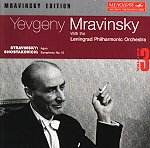
Vol. 3 STRAVINSKY SHOSTAKOVICH rec 1965
and 1976
Stravinsky's Agon ballet is amongst his driest works but in Mravinsky's hands
it comes alive. Shostakovich's kaleidoscopic puzzle of a 15th symphony was
not premiered by Mravinsky however within four months of Maxim's Moscow premiere
Mravinsky gave a performance in Leningrad. The Mahlerian collision between
populist highlights from Rossini and volcanic tragedy had many scratching
their heads. Mravinsky leaves the contrast in full focus and is a strong
advocate for the work. This performance dates from a concert given on 26
May 1976 to commemorate the composer who had died in 1975. The clockwork
of eternity ringing and clicking in the final bars is well done by the
Leningraders.
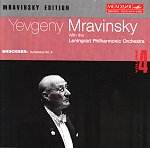
Vol. 4 BRUCKNER rec 1980
Bruckner is not instantly a name one associates with Mravinsky. Tchaikovsky
and Shostakovich? yes, but Bruckner? In fact he introduced Bruckner No. 4
to Leningrad audiences within a year of being appointed conductor of the
Leningrad orchestra in 1938. In 1939 he added No. 7 and in 1940 No. 9. This
concert tape of Symphony No. 9 dates from 1980 and sounds clean and powerful
with just that invigorating edge one associates with Russian performances
and recordings. Mravinsky's approach is very sharply etched - a clarion purity
which is given some memorable juiciness and spice by the Russian accented
brass choir. The bray is nowhere near as pronounced as one is used to from
Russian orchestras recorded in the 1950s and 1960s but it is still there.
Presumably the softened edge was due to the increasing import of Western
sourced instruments and techniques. The strings are wondrously light-toned
in Bruckner's many sunny uplands - try 16.58 in the third movement.

Vol. 5 TCHAIKOVSKY PROKOFIEV rec
1981
Here we veer back into the Russian vein. The Nutcracker suite (six numbers)
is done with a light fantasy (compare the late 1940s version in Vol 2) but
with just the right hint of darkness to settle the glycerine and caramel
of this oft-derided score. Romeo and Juliet is a classic of Mravinsky's
repertoire - hyper-romantic, raw emotions, epic horns in a strident blaze
of agony and triumph. At just under an hour this is among the shorter playing
times.
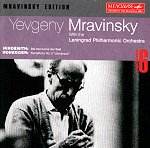
Vol. 6 HINDEMITH HONEGGER rec
1965
These tapes emanate from the famous series of Moscow Grand Hall concerts
in 1965. Neither fits the two mainstreams identified above. The Hindemith
symphony Die Harmonie der Welt has some Russian linkages and, as you would
expect, fully projects a Mravinskian spirit. Hindemith visited Russia twice
as violist with the Amar Quartet. His opera Neues von Tage (seen as a scandalous
work at the time) was to have been performed in Leningrad in 1929-1930. However
this was not to be as Stalinism began to put up the shutters. This performance
was given just over a year after the 'freeze' had ended with Mravinsky giving
the Russian premiere of the work. Its lyrical intensity completely confounds
the usual image of Hindemith and this recording could easily be used to win
friends for Hindemith's often slighted music.
Much the same can be said about the Honegger whose music also suffers from
a dried-out image. The fruity tragedy of the war-torn symphony No. 3 makes
for parallels with Shostakovich 6; another work done with typical blaze by
Mravinsky.
This disc plays for just over an hour.
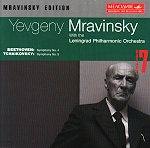
Vol. 7 BEETHOVEN and
TCHAIKOVSKY rec 1973
In this disc classical and Russian mainstreams meet. The classical poise
of Beethoven's 4th symphony is as well done (and without incongruous infusions
of Russian intensity) as the ripe romanticism of Tchaik Symphony No. 5. The
late Tchaikovsky symphonies, since their DG recordings (1950s mono - Sanderling
did No. 4 - or 1960s stereo sets), will always be associated with Mravinsky
and the Leningraders. This performance in its ebb, flow and sweep is impressive
but lacks a degree or so of the warmth of the DG stereo version.
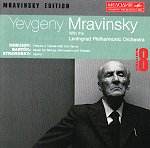
Vol. 8 DEBUSSY BARTOK STRAVINSKY rec
1965
These again are sourced from tapes of the live concerts in 1965 at the Moscow
Great Hall. The Debussy (Prelude a l'apres-midi d'un faune) is dreamy but
with a clarity that struck me anew in Mravinsky's hands. The Bartok has a
Russian spirit that seems to come from Prokofiev at least as we hear the
work (Music for strings, percussion and celesta) here. The Stravinsky ballet
(Apollo) remains, for me, unlovable - as much of a challenge as Agon.
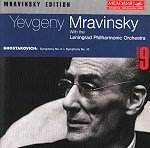
Vol. 9 SHOSTAKOVICH
Symphonies 6 and 10 are given with the raw power you would expect. No. 6's
devastating Largo (which I find amongst the most powerful documents in all
Shostakovich's output) comes across very strongly in this 1972 performance.
The other two movements always strike me as real incongruities. No. 10 is
done with resentful abrasion and a scorching blast.
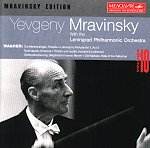
VOL. 10. WAGNER
Lastly there is a collection of Wagner chunks - concert-pieces of the type
often anthologised on disc by Stokowski, Boult and a host of others. The
Meistersinger prelude recorded in Mravinsky's final (and on this showing
rather tired) year (1982) with the Leningraders is rather heavy of plod though
lightened momentarily by the piercing trumpets that crown the closing bars.
A drowsy numbness oozes though the veins of the Tannhauser overture also
(rec 1978). More impressive is the indomitable swing and serene weave of
the Lohengrin Act I prelude recorded in 1978. The starry strings are the
epitome of a romantic spirit that was to hang over music into the 1930s.
The slightly enervating air which cloys these pages is blown to the four
winds by one of the most explosive Act III Lohengrin preludes (rec live in
1965) with devastating trumpets and rippling wind instruments. This one has
to be heard! A slack Siegfried's Funeral March disappoints despite heaven-clawing
brass. This piece should positively spark and flame with crackling Brucknerian
tension. In Mravinsky's hands it does not. A funeral march does not need
to sleep. The disc returns to glorious form with another 1965 recording;
this time of The Ride of the Valkyries. The strings shriek and wheel around
the skies and the brass, blackened by battle, rush in dark legions across
the landscape. The pace may well have been too much for the brass players
and loosens up towards the end.
Reviewer
Rob Barnett


